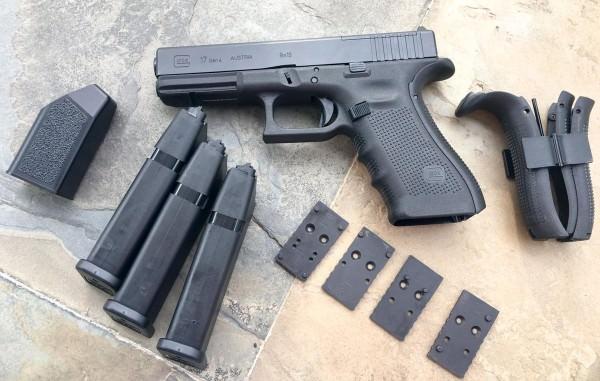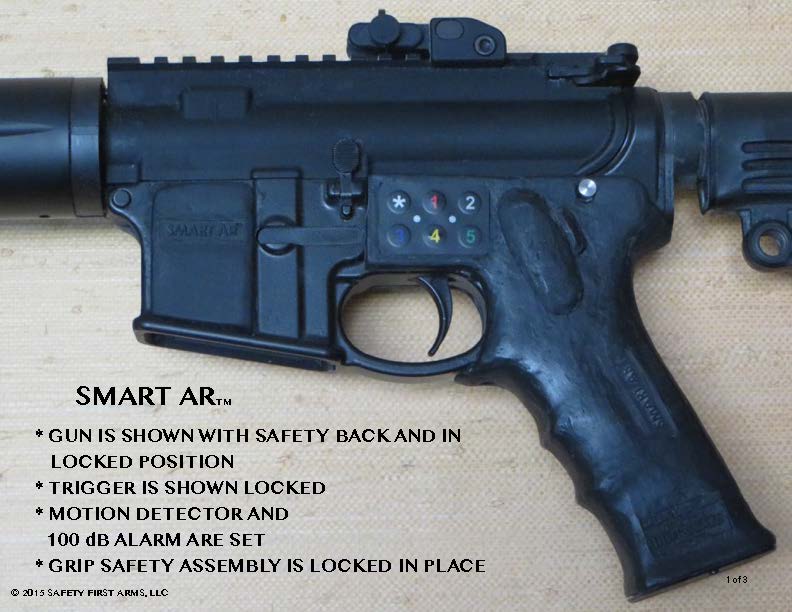Targeting First-Time Buyers: The 3D Printed Smart 2 Gun Deters Handling, Tampering & Theft via Electronic PIN
 In a world rife with highly publicized mass shootings, whether they be international or domestic terrorism and whether they emanate from calculated killers or the confused and mentally ill (perhaps all one and the same in the very end), the gun itself is certainly under fire. It’s no secret that people around the world, and very much so in the US, are up in arms—yet mostly without realistic solutions.
In a world rife with highly publicized mass shootings, whether they be international or domestic terrorism and whether they emanate from calculated killers or the confused and mentally ill (perhaps all one and the same in the very end), the gun itself is certainly under fire. It’s no secret that people around the world, and very much so in the US, are up in arms—yet mostly without realistic solutions.
With the need for tighter gun control and more constrictive background checks in a constant state of inflammatory debate from legislature to conversation at the dining room table, one very smart startup, Safety First Arms, has been busy behind the scenes working on a solution.
Their design centers around what could be considered a baseline for handguns: the Glock. Well-known for its use by police officers, the Glock 17 is a basic and versatile gun. It’s available, known to be reliable, and those interested in buying one need only come up with around $600 to walk away as gun-owners, often first-time buyers.
The SFA team (not affiliated with Glock) evaluated the ubiquitous design, and with the benefit of digital design, 3D printing, and specialized security electronics, went on to create the smart gun of the future, which is actually compatible with Glock magazines and parts. While you can pre-order one now (and receive a $100 discount) for an estimated $1295, the 3D printed Smart 2 handgun will not be shipping until 2018.
“It’s expensive; it’s not an everyman’s gun,” said Lenny Magill, CEO of GlockStore, the company lined up to be the first distributor of the Smart 2. “The hardcore gun enthusiast is not going to buy this. But some people will, and that’s admirable.”
Indeed, the price alone may keep many from even investigating the idea, but others will appreciate the smart keypad accentuated with bright primary colors. Not relying on a fingerprint (if you’ve tried to use one of these just to unlock your smartphone on a daily basis, you probably know that it can be trying at times) or radio frequency identification (requiring you to wear an accompanying RFID tether such as a ring or watch), the Smart 2 simply requires that you know your PIN, which unlocks the gun in less than a second.
This is not complicated by any means, but it could be what makes the difference in allowing more access for gun-owners, as well as providing safety—disallowing the gun to be used when in the wrong hands or picked up by a child. Forbes points to a recent survey by Johns Hopkins supporting the idea that some new users would be interested in this type of technology:
“The results of this study show that there is potentially a large commercial market for smart gun technology,” says Julia A. Wolfson, MPP, a Lerner Fellow with the Bloomberg School’s Center for a Livable Future and a PhD candidate in the Department of Health Policy and Management. “This has been one of the biggest arguments against smart guns, that people just don’t want them. This research shows otherwise.”
The Smart 2 is being marketed to this population of progressive and concerned gun buyers—generally thinking about buying their first gun, but concerned about the safety aspects. And while certainly not the first smart gun to be designed and marketed, it does offer a realistic approach for use, while still in line with National Institute of Justice standards.
“It doesn’t need to be high tech. It just needs to work,” says co-founder Brian Weinberg.
Should the personalized PIN be entered incorrectly too many times a piercing alarm is raised. SFA also plans to offer an option for gun-owners with the motion sensitive alarm—sounding if the weapon is picked up but no PIN is entered.
“The SMART 2 prevents unauthorized firing but unlocks in under a second with your PIN code,” states SFA on their website. “Releasing the grip safety re-locks the gun in one-third of a second and guards against take-away.”
Although there is a 12-hour unlock mode, the Smart 2 also features a Theft Guard system, with no wireless access. This is meant to eliminate hacking concerns, and anyone attempting to steal the 9mm gun will be met with the motion-triggered siren.
“Outside of a larger safe, no other gun can protect like this,” says SFA.
Batteries are always a consideration, and of course, especially for prospective gun buyers who often envision their gun as a potential life-saving device. A dead battery could put the user in a helpless situation, and with that concern in mind, the Smart 2 is equipped with a long-life battery.
This new smart gun has been fully completed in prototype, and for SFA, that just means the easiest part of the journey has been completed in bringing the Smart 2 to market. Now, Weinberg and co-founder Bob Allan need to raise capital of around $10 million, and finding money for a new gun is no easy feat. Crowdfunding isn’t weapons-friendly for the most part, and smart guns have not been widely embraced.
“No one wants to touch it,” Weinberg says.
However, this isn’t something new for the team, persistent in their goals. Bob Allan has been working on a smart gun since 2002, beginning with a safety mechanism for the trigger, which he put on the back burner for quite some time after smart guns drew heavy criticism from groups like the NRA. Several years ago though, motivated by the grief of two different friends committing suicide, Allan brought his project back into the light.
“A gun is so easy… and often it’s done with the household gun,” said Allan, a gun enthusiast and hunter. “I figured there’s got to be a way around this.”
At this point, he partnered up with Weinberg to make a realistic, marketable smart gun that offers both security and fast access. Fast forward to today, and the two have invested $500,000 in the Smart 2 concept, along with three years of R&D.
“We’re building the system to be more reliable than a (traditional) handgun,” Weinberg says, adding, “if it’s a protective weapon, what’s the good of it if it doesn’t work? The ultimate goal is to give the user more access to their firearm, but not increase the risk.”
The SFA team also has plans to extend their technology to the long gun, working from the AR-15 semi-automatic rifle design. While the challenges that have met other smart guns certainly may apply in their work as well, Weinberg and Allan forge ahead confidently. And perhaps, they may be entering the marketplace at exactly the right time, closing the gap in a world that often feels frightening—and as everyone looks for better solutions in how weapons are obtained, handled, and controlled from the personal level. What are your thoughts on this new weapon? Discuss further in the 3D Printed Smart 2 Handgun forum over at 3DPB.com.
[Source: Safety First Arms; Forbes / Images: SFA]Subscribe to Our Email Newsletter
Stay up-to-date on all the latest news from the 3D printing industry and receive information and offers from third party vendors.
You May Also Like
US Army Corps of Engineers Taps Lincoln Electric & Eaton for Largest 3D Printed US Civil Works Part
The Soo Locks sit on the US-Canadian border, enabling maritime travel between Lake Superior and Lake Huron, from which ships can reach the rest of the Great Lakes. Crafts carrying...
Construction 3D Printing CEO Reflects on Being Female in Construction
Natalie Wadley, CEO of ChangeMaker3D, could hear the words of her daughter sitting next to her resounding in her head. “Mum, MUM, you’ve won!” Wadley had just won the prestigious...
Blue Laser-powered M600 3D Printer Launched by Meltio
Founded in 2019 as a joint venture between Additec and Sicnova, metal 3D printer OEM Meltio develops and manufactures high-performance and easy-to-use metal 3D printing solutions that use its patented wire-laser metal...
3D Printed Storage Tanks Cut Material Costs by 25%
In a previous article, “Concrete Dreams: Let’s Print Money, Not Houses,” we discussed how the spotlight on 3D printing homes might be misplaced. Bollards, pedestrian bridges, and concrete tanks could...
































